Distributed computing systems offer a wide array of advantages over
centralized computing systems. Here data is stored in a distributed way
with several nodes as servers.

GlusterFS Storage
The concept of a metadata server is no longer needed in a distributed
file system. In distributed file systems, it offers a common view point
of all the files separated among different servers. Files/directories
on these storage servers are accessed in normal ways.
For example, the permissions for files/directories can be set as in
usual system permission model, i.e. the owner, group and others. The
access to the file system basically depends on how the particular
protocol is designed to work on the same.
What is GlusterFS?
GlusterFS is a distributed file system defined to be used in user space, i.e. File System in User Space (
FUSE). It is a software based file system which accounts to its own flexibility feature.
Look at the following figure which schematically represents the
position of GlusterFS in a hierarchical model. By default TCP protocol
will be used by GlusterFS.
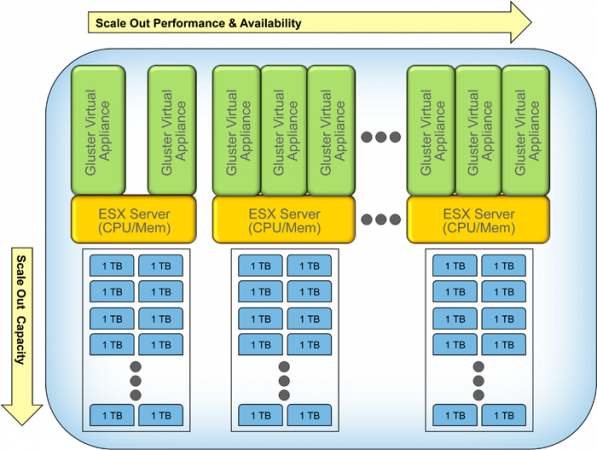
GlusterFS Design
Advantages to GlusterFS
- Innovation – It eliminates the metadata and can dramtically improve the performance which will help us to unify data and objects.
- Elasticity – Adapted to growth and reduction of size of the data.
- Scale Linearly – It has availability to petabytes and beyond.
- Simplicity – It is easy to manage and independent from kernel while running in user space.
What makes Gluster outstanding among other distributed file systems?
- Salable – Absence of a metadata server provides a faster file system.
- Affordable – It deploys on commodity hardware.
- Flexible – As I said earlier, GlusterFS is a software only file system. Here data is stored on native file systems like ext4, xfs etc.
- Open Source – Currently GlusterFS is maintained by Red Hat Inc, a billion dollar open source company, as part of Red Hat Storage.
Storage concepts in GlusterFS
- Brick – Brick is basically any directory that is meant to be shared among the trusted storage pool.
- Trusted Storage Pool – is a collection of these shared files/directories, which are based on the designed protocol.
- Block Storage – They are devices through which the data is being moved across systems in the form of blocks.
- Cluster – In Red Hat Storage, both cluster and
trusted storage pool convey the same meaning of collaboration of storage
servers based on a defined protocol.
- Distributed File System – A file system in which
data is spread over different nodes where users can access the file
without knowing the actual location of the file. User doesn’t experience
the feel of remote access.
- FUSE – It is a loadable kernel module which allows
users to create file systems above kernel without involving any of the
kernel code.
- glusterd – glusterd is the GlusterFS management
daemon which is the backbone of file system which will be running
throughout the whole time whenever the servers are in active state.
- POSIX – Portable Operating System Interface (POSIX)
is the family of standards defined by the IEEE as a solution to the
compatibility between Unix-variants in the form of an Application
Programmable Interface (API).
- RAID – Redundant Array of Independent Disks (RAID) is a technology that gives increased storage reliability through redundancy.
- Subvolume – A brick after being processed by least at one translator.
- Translator – A translator is that piece of code
which performs the basic actions initiated by the user from the mount
point. It connects one or more sub volumes.
- Volume – A volumes is a logical collection of
bricks. All the operations are based on the different types of volumes
created by the user.
Different Types of Volumes
Representations of different types of volumes and combinations among these basic volume types are also allowed as shown below.
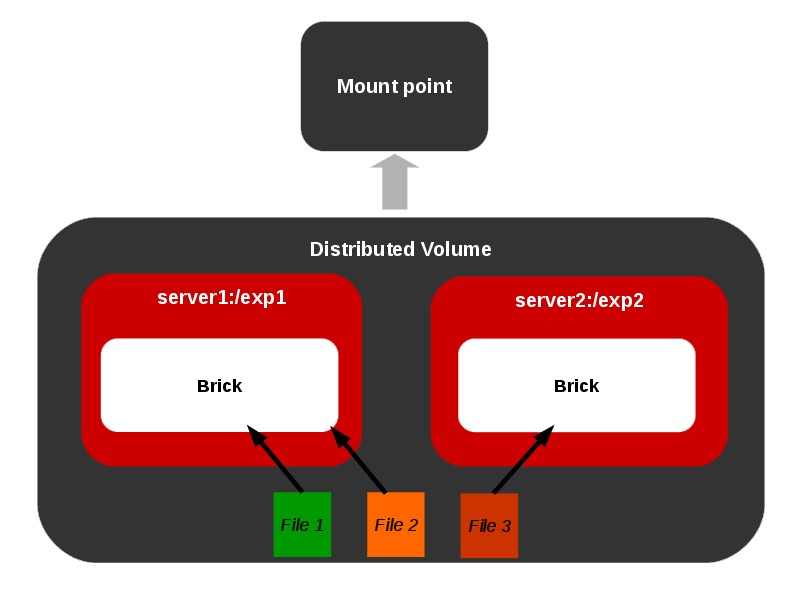
Distributed Volume
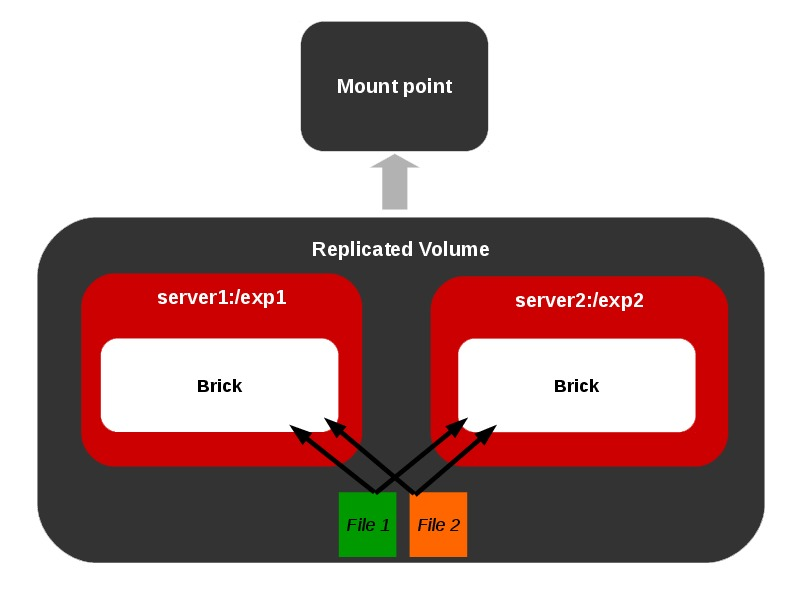
Replicated Volume
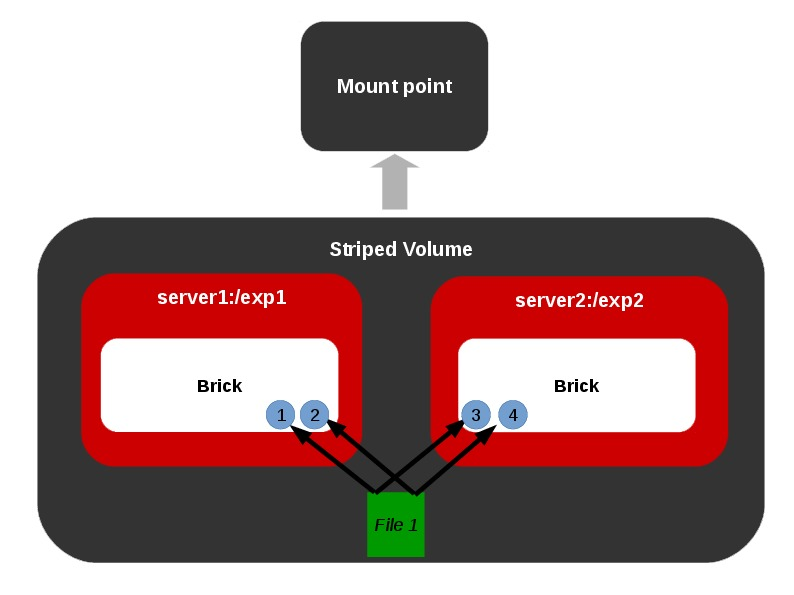
Striped Volume
Distributed Replicated Volume
Representation of a distributed-replicated volume.
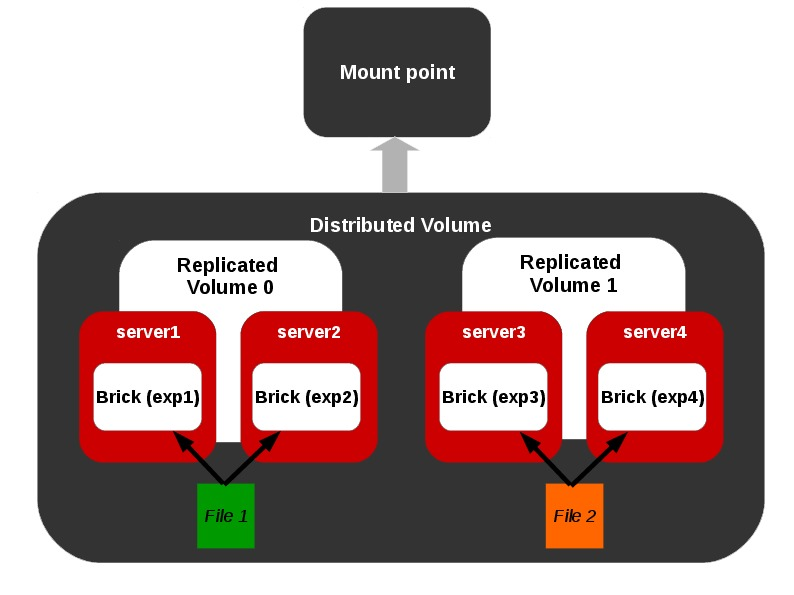
Distributed Replicated Volume
Installation of GlusterFS in RHEL/CentOS and Fedora
In this article, we will be installing and configuring GlusterFS for
the first time for high availability of storage. For this, we’re taking
two servers to create volumes and replicate data between them.
Step :1 Have at least two nodes
- Install CentOS 6.5 (or any other OS) on two nodes.
- Set hostnames named “server1” and “server2“.
- A working network connection.
- Storage disk on both nodes named “/data/brick“.
Step 2: Enable EPEL and GlusterFS Repository
Before Installing GlusterFS on both the servers, we need to enable
EPEL and
GlusterFS
repositories in order to satisfy external dependencies. Use the
following link to install and enable epel repository under both the
systems.
- How to Enable EPEL Repository in RHEL/CentOS
Next, we need to enable GlusterFs repository on both servers.
# wget -P /etc/yum.repos.d http://download.gluster.org/pub/gluster/glusterfs/LATEST/EPEL.repo/glusterfs-epel.repo
Step 3: Installing GlusterFS
Install the software on both servers.
# yum install glusterfs-server
Start the GlusterFS management daemon.
# service glusterd start
Now check the status of daemon.
# service glusterd status
Sample Output
service glusterd start
service glusterd status
glusterd.service - LSB: glusterfs server
Loaded: loaded (/etc/rc.d/init.d/glusterd)
Active: active (running) since Mon, 13 Aug 2012 13:02:11 -0700; 2s ago
Process: 19254 ExecStart=/etc/rc.d/init.d/glusterd start (code=exited, status=0/SUCCESS)
CGroup: name=systemd:/system/glusterd.service
├ 19260 /usr/sbin/glusterd -p /run/glusterd.pid
├ 19304 /usr/sbin/glusterfsd --xlator-option georep-server.listen-port=24009 -s localhost...
└ 19309 /usr/sbin/glusterfs -f /var/lib/glusterd/nfs/nfs-server.vol -p /var/lib/glusterd/...
Step 4: Configure SELinux and iptables
Open ‘
/etc/sysconfig/selinux‘ and change SELinux to either “
permissive” or “
disabled” mode on both the servers. Save and close the file.
# This file controls the state of SELinux on the system.
# SELINUX= can take one of these three values:
# enforcing - SELinux security policy is enforced.
# permissive - SELinux prints warnings instead of enforcing.
# disabled - No SELinux policy is loaded.
SELINUX=disabled
# SELINUXTYPE= can take one of these two values:
# targeted - Targeted processes are protected,
# mls - Multi Level Security protection.
SELINUXTYPE=targeted
Next, flush the iptables in both nodes or need to allow access to the other node via iptables.
# iptables -F
Step 5: Configure the Trusted Pool
Run the following command on ‘
Server1‘.
gluster peer probe server2
Run the following command on ‘
Server2‘.
gluster peer probe server1
Note: Once this pool has been connected, only trusted users may probe new servers into this pool.
Step 6: Set up a GlusterFS Volume
On both
server1 and
server2.
# mkdir /data/brick/gv0
Create a volume On any single server and start the volume. Here, I’ve taken ‘
Server1‘.
# gluster volume create gv0 replica 2 server1:/data/brick1/gv0 server2:/data/brick1/gv0
# gluster volume start gv0
Next, confirm the status of volume.
# gluster volume info
Note: If in-case volume is not started, the error messages are logged under ‘
/var/log/glusterfs‘ on one or both the servers.
Step 7: Verify GlusterFS Volume
Mount the volume to a directory under ‘
/mnt‘.
# mount -t glusterfs server1:/gv0 /mnt
Now you can create, edit files on the mount point as a single view of the file system.
Features of GlusterFS
- Self-heal – If any of the bricks in a replicated
volume are down and users modify the files within the other brick, the
automatic self-heal daemon will come into action as soon as the brick is
up next time and the transactions occurred during the down time are
synced accordingly.
- Rebalance – If we add a new brick to an existing
volume, where large amount of data was previously residing, we can
perform a rebalance operation to distribute the data among all the
bricks including the newly added brick.
- Geo-replication – It provides back-ups of data for
disaster recovery. Here comes the concept of master and slave volumes.
So that if master is down whole of the data can be accessed via slave.
This feature is used to sync data between geographically separated
servers. Initializing a geo-replication session requires a series of
gluster commands.
Here, is the following screen grab that shows the Geo-replication module.
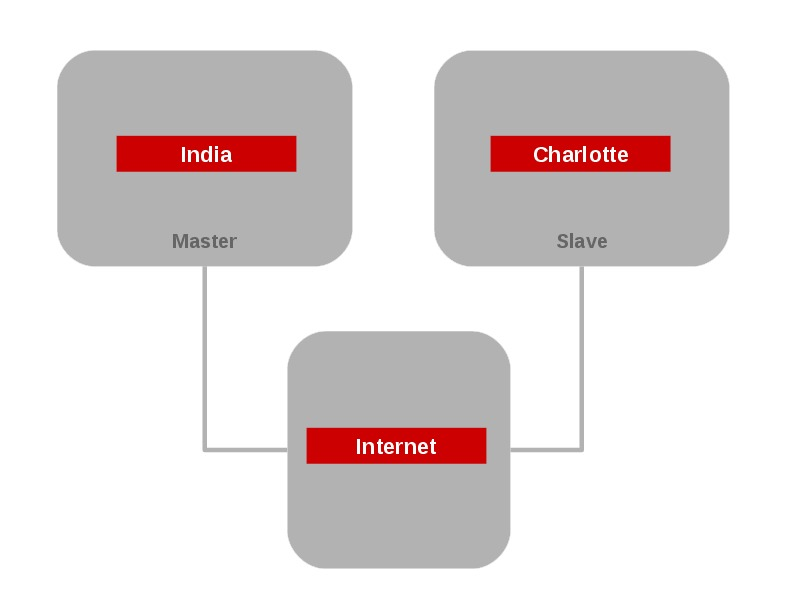
Geo Replication







 All you need to provide is your name, email address, and
password and the email account set up wizardry will check our database
and find the email settings for you.
All you need to provide is your name, email address, and
password and the email account set up wizardry will check our database
and find the email settings for you. Ever dreamed of having a personalized email address (such as
"dad@thesmithfamily.com") for you, your family or your business?
Thunderbird makes this easy - you can sign up for a new email address
within Thunderbird, and it will all be set up automatically for you
ready to send and receive.
Ever dreamed of having a personalized email address (such as
"dad@thesmithfamily.com") for you, your family or your business?
Thunderbird makes this easy - you can sign up for a new email address
within Thunderbird, and it will all be set up automatically for you
ready to send and receive.




 You can now search the Web without having to leave Thunderbird.
Type whatever comes to mind in Thunderbird's search box and choose from
several different search providers.
You can now search the Web without having to leave Thunderbird.
Type whatever comes to mind in Thunderbird's search box and choose from
several different search providers.





